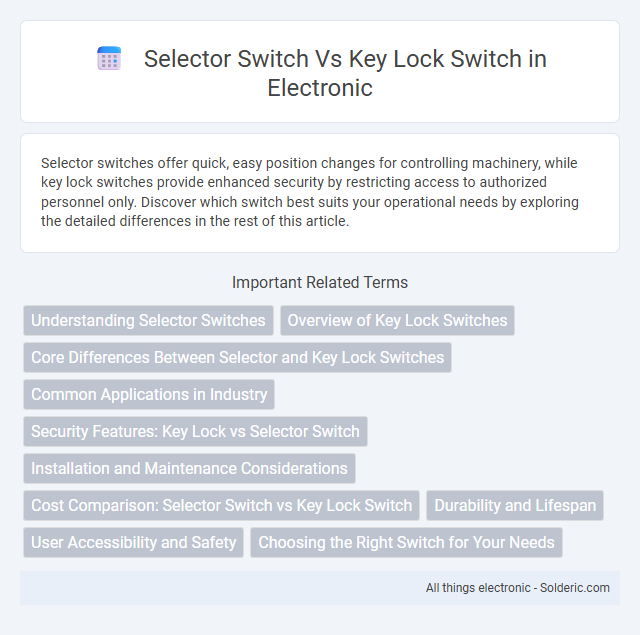Selector switches offer quick, easy position changes for controlling machinery, while key lock switches provide enhanced security by restricting access to authorized personnel only. Discover which switch best suits your operational needs by exploring the detailed differences in the rest of this article.
Comparison Table
| Feature | Selector Switch | Key Lock Switch |
|---|---|---|
| Function | Selects multiple positions or modes in a circuit | Locks/unlocks control circuits to restrict access |
| Operation | Rotary or toggle to choose settings | Requires key to turn switch on/off |
| Security Level | Low - accessible to anyone | High - access controlled by key |
| Common Applications | Control panels, machinery mode selection | Safety lockouts, restricted equipment access |
| Installation | Simple, requires panel cutout | Complex, includes lock mechanism |
| Cost | Generally lower cost | Higher cost due to locking feature |
| Maintenance | Minimal, electrical wear only | Requires key management and mechanical upkeep |
Understanding Selector Switches
Selector switches provide reliable, multi-position control for industrial machinery, enabling operators to choose modes or functions with a simple turn. These switches often feature clear labeling and tactile feedback, enhancing usability and safety in complex control panels. Unlike key lock switches, selector switches do not require a key, allowing for quicker access while still maintaining precise operational control.
Overview of Key Lock Switches
Key lock switches provide enhanced security by requiring a physical key to change the switch position, making them ideal for controlling access to sensitive equipment or settings. These switches are commonly used in industrial and commercial applications where unauthorized operation must be prevented. Your devices benefit from increased protection against tampering and accidental activation with key lock switches.
Core Differences Between Selector and Key Lock Switches
Selector switches offer multiple positions for controlling machinery or systems by rotating a knob, enabling operational flexibility in industrial applications. Key lock switches require a key to operate, providing enhanced security by restricting access and preventing unauthorized activation or changes. The core difference lies in selector switches prioritizing ease of use and versatility, while key lock switches focus on security and controlled access.
Common Applications in Industry
Selector switches are commonly used in industrial control panels for machine operation mode selection, allowing operators to toggle between different settings such as start, stop, or emergency stop with ease. Key lock switches provide added security by restricting access to authorized personnel only, often found in critical systems like security alarms, power isolation, or unauthorized machinery activation. Your choice between the two depends on the level of control and security required in your industrial environment.
Security Features: Key Lock vs Selector Switch
Key lock switches provide enhanced security by requiring a physical key to operate, preventing unauthorized access and accidental activation. Selector switches rely on manual toggling without physical key control, making them less secure in environments where access restriction is critical. Your choice should consider the level of security needed, with key lock switches offering superior protection for sensitive applications.
Installation and Maintenance Considerations
Selector switches offer straightforward installation due to their snap-in or screw-mount designs, enabling easy panel integration and quick wiring connections, which reduces setup time. Key lock switches require precise alignment and secure mounting to prevent unauthorized access, often involving additional hardware and more complex wiring configurations. Maintenance for selector switches is typically minimal, focusing on contact cleaning, while key lock switches demand regular inspection of locking mechanisms to ensure security and operational integrity.
Cost Comparison: Selector Switch vs Key Lock Switch
Selector switches generally cost less than key lock switches due to their simpler design and lower manufacturing complexity. Key lock switches involve additional components such as keys and locking mechanisms, increasing production and maintenance expenses. Choosing between the two depends on budget constraints and security requirements, with selector switches favored for cost efficiency and key lock switches for enhanced access control.
Durability and Lifespan
Selector switches typically feature robust mechanical components designed to withstand frequent use and harsh environments, offering high durability and a long operational lifespan. Key lock switches provide enhanced security with a locking mechanism that prevents unauthorized operation, often resulting in increased wear resistance but potentially shorter lifespans if keys are mishandled. Both types are engineered for industrial settings, but selector switches generally exhibit better longevity under heavy-duty conditions, while key lock switches prioritize controlled access and may require more maintenance to sustain durability.
User Accessibility and Safety
Selector switches offer enhanced user accessibility with intuitive control, enabling quick and easy operation through simple toggling or rotating mechanisms. Key lock switches provide superior safety by restricting access to authorized personnel only, reducing the risk of accidental or unauthorized activation. Combining both types ensures optimal balance between ease of use and security in industrial or control panel applications.
Choosing the Right Switch for Your Needs
Choosing the right switch depends on your security and functionality requirements; selector switches offer easy toggling between multiple positions for operational control, while key lock switches provide enhanced security by restricting access to authorized users only. Selector switches are ideal for applications requiring quick mode changes without compromising efficiency, whereas key lock switches ensure that critical functions cannot be accidentally or maliciously altered. Evaluate whether your priority is convenience or controlled access to determine the most suitable option for your system.
selector switch vs key lock switch Infographic

 solderic.com
solderic.com